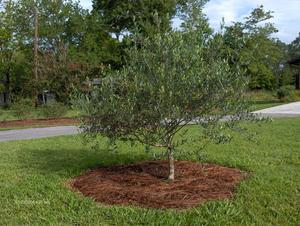 PLANTING
PLANTING Olive trees require a well-drained soil and a sunny position. Avoid sites where water stands during rainy periods or where ground water seeps into a hole two feet deep. Except for water-logged, mucky or extremely acidic sites, most Florida soils are ideal for olive tree culture. Do not, however, confuse the olive for a desert plant. It needs regular watering to thrive. Insufficient water will cause your tree to suffer, and even die if left too dry for too long.
Choose a site that receives at least six hours of direct sun per day. Full sun is ideal.
Plant your tree at the depth it has been growing in the pot; planting too deep is worse than planting too shallow. Do not amend the soil with organic material, moisture-retaining polymers, fertilizer or anything else. Simply plant in the native soil (provided it is well-drained) and backfill with the same.
If your tree requires staking, it will already have a stake in the pot. A very young tree may require a heavier stake as it grows. Once the trunk caliper reaches one inch in diameter (or perhaps less for shrub-form or short trees), it will no longer require a stake. Until then, use a stake large enough to hold the trunk upright. Put the new stake in the same hole the previous stake occupied and tie the tree to the stake with arborists' tape such as comes with your staked tree. Do not use wires, water hoses, cables, guying systems or other means of securing your tree. A good stout stake and the proper tape is all you need.
FERTILIZATION
Olive trees do not need special olive tree fertilizer but results will be exponentially more satisfactory with a good nutrition regimen. If planting is done after mid-October but before March 1, do not fertilize at the time of planting; wait until March. Otherwise, fertilize after planting and regularly throughout the growing season. How regularly will depend upon the type of fertilizer used. We at Olive Tree Growers prefer to use a premium slow-release fertilizer such as Osmocote Plus (with essential minor elements); however, this product is not widely available through retail stores or in small packages. Many garden centers do sell Osmocote without minors in homeowner-sized packages and this may be used especially if augmented with another product from Southern Agricultural Insecticides called "Essential Minor Elements" or some other brand of minor elements package. Olive Tree Growers believes that some sort of minors package is important, as many soils are lacking in some essential minerals which aid plant growth in several ways.
A fast-release farm-type fertilizer may be used according to label directions. Many such fertilizers contain some minor elements and are widely available. Be sure to water very well after application. These fertilizers are generally not for use on plants in pots.
Fertilizers labeled for use on lawns have a very high ratio of nitrogen to phosphorus and potassium and should be avoided. Liquid fertilizers such as Miracle Gro may be used (again, a formulation with minor elements is best) but it should be remembered that liquid feeding is a fleeting thing and must be repeated often.
Organically-derived fertilizers are available and a good thing though often more expensive. Top dressing with organic material such as composted manure or kitchen compost can be done but the grower should consult the current literature. It can be difficult to achieve a good balance of nutritional elements by this method. It is environmentally responsible but requires more study and understanding by the gardener. Always avoid placing compost or any fertilizer next to the trunk of the tree.
Whatever type of fertilizer is used, it is best to feed lightly and often during the growing season. Avoid heavy applications of fast release fertilizer that could damage plants and leach or run-off into groundwater. Always read and follow label instructions. Do not fertilize after mid-August or before mid- March unless you live in a very warm climate.
If your tree is planted in a lawn area, take care that lawn maintenance practices do not harm the tree. Do not allow "Weed and Feed" products to be used anywhere near your tree. These products are designed to feed lawn grasses and destroy other plants. Remember that the roots of a tree extend far beyond the drip-line of the branches. Also, do not allow weed-eater operators anywhere near your tree. Weed-eater operators kill thousands of trees every year by "girding," or removing the bark from the bases of trees.
MULCH
Wood chips are bad, okay? Do not use wood chips, cypress mulch or any cellulose product for mulch. These products are high in carbon and rob the soil of nitrogen and other nutrients in the decomposition process. They also hold too much water in wet periods and once dry, shed irrigation water and rainfall like a shingle roof. We prefer to use only pine straw for mulch and keep it back several inches from the trunk; do not allow a build-up of decomposed mulch around the base of the tree trunk.
WATERING
Once established, olive trees are among the most drought-resistant trees in the world. That doesn't mean they prefer to suffer for water. You will have to water sufficiently to get your tree established and thereafter as necessary during very dry periods. No one can give you a formula for that; you will have to observe and evaluate.
PRUNING
Olive trees may be pruned to the desired shape. Some people prefer a tree form; others like a rounded shrub as is done in production groves to facilitate picking of the fruit. Pruning between mid-February and the ripening of fruit in the fall, except for the lightest tipping of new shoots, will result in a reduced crop. Otherwise, prune to the desired shape. Keep in mind that olives bear their fruit on last year's new growth.
PESTS
The only pests we have known to attack olive trees outside of olive producing regions is an armored scale insect. It is not common but should be watched for, especially if your site has other species prone to harbor scale insects. Inspect the trees by looking under the leaves and in the branch axils for a dark bump the size of a "BB." These insects do not move in the adult stage; they attach themselves like barnacles. The presence of sooty mold on leaves and bark indicates scale; this mold grows on the scales' secretions.
If scale is found, it may be treated with a variety of products, depending upon personal preference. Consult your local garden center. It may also be removed by hand if you have only one or a few trees.
Finally, be sure to keep ant colonies away from your trees.
http://www.olivetreegrowers.com/blog.php?view=detail&id=19

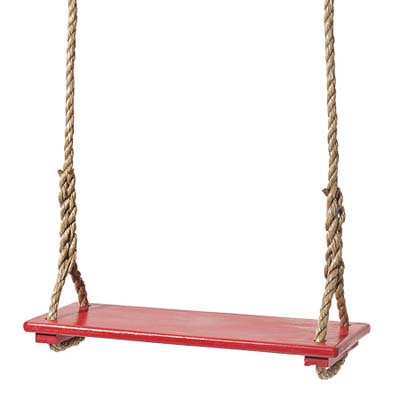
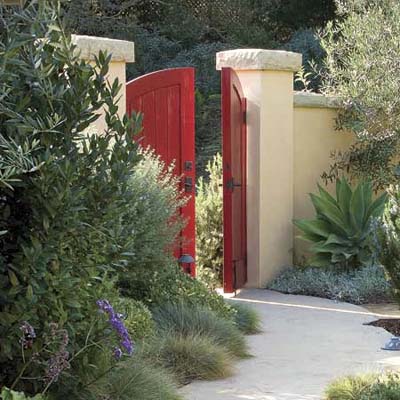




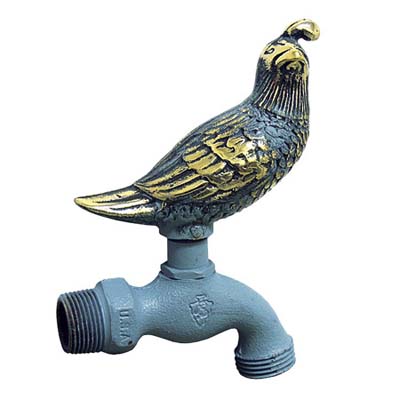


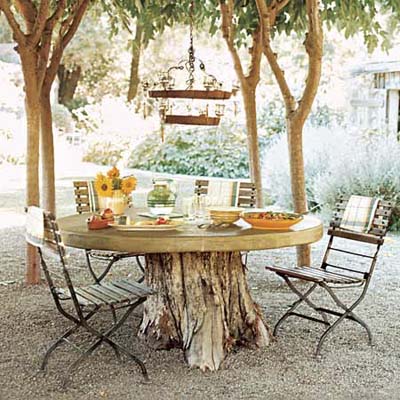


































 PLANTING Olive trees require a well-drained soil and a sunny position. Avoid sites where water stands during rainy periods or where ground water seeps into a hole two feet deep. Except for water-logged, mucky or extremely acidic sites, most Florida soils are ideal for olive tree culture. Do not, however, confuse the olive for a desert plant. It needs regular watering to thrive. Insufficient water will cause your tree to suffer, and even die if left too dry for too long.
PLANTING Olive trees require a well-drained soil and a sunny position. Avoid sites where water stands during rainy periods or where ground water seeps into a hole two feet deep. Except for water-logged, mucky or extremely acidic sites, most Florida soils are ideal for olive tree culture. Do not, however, confuse the olive for a desert plant. It needs regular watering to thrive. Insufficient water will cause your tree to suffer, and even die if left too dry for too long. 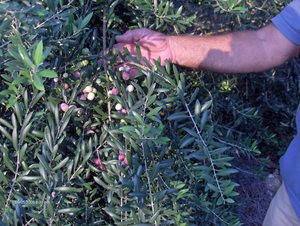 by Cary Cloud
by Cary Cloud 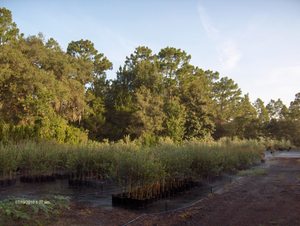 The first thing to determine when purchasing an olive tree is that it is, indeed, the fruiting Mediterranean olive, Olea europaea. Many other plants have the word "olive" in their common names, such as Tea Olive (Osmanthus fragrans), Black Olive (Bucida buceras), and Russian Olive (Elaeagnus angustifolia). There is also the African Olive, known variously as Olea africanus, Olea europaea subspecies africanus and Olea europaea subspecies cuspidata, which makes a tiny fruit and is considered a pest plant in many regions. Olea europaea cultivars can be grafted onto African olive. These trees can branch from below the graft union and produce the undesirable fruits.
The first thing to determine when purchasing an olive tree is that it is, indeed, the fruiting Mediterranean olive, Olea europaea. Many other plants have the word "olive" in their common names, such as Tea Olive (Osmanthus fragrans), Black Olive (Bucida buceras), and Russian Olive (Elaeagnus angustifolia). There is also the African Olive, known variously as Olea africanus, Olea europaea subspecies africanus and Olea europaea subspecies cuspidata, which makes a tiny fruit and is considered a pest plant in many regions. Olea europaea cultivars can be grafted onto African olive. These trees can branch from below the graft union and produce the undesirable fruits.